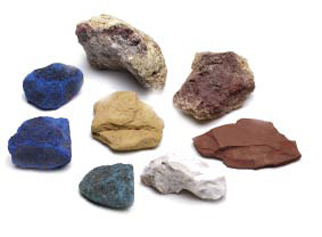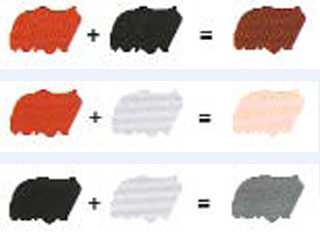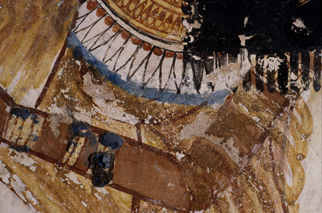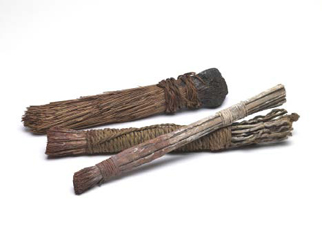5 Applying the paint
The range of colours used in Eighteenth Dynasty tomb-chapels was relatively small. It goes without saying that it was nothing like the huge range of synthetic colours available today, or even the range available to artists over the last five hundred years in the medium of oil paint.
The principal colours available were black, white, red, yellow, green and blue (Figure 20).

Black was derived from carbon, obtained from sources such as lampblack, or soot on the bottom of cooking utensils, or ground charcoal. White came from chalk or gypsum, resulting in two distinct types: a kind of creamy white often used for backgrounds, and a brighter, shinier white used for items such as clothes and jewellery. Red and yellow were derived from naturally occurring ochres (these continued to be used in the European tradition, as well as in other traditions including contemporary Australian Aboriginal bark painting). Figure 21 shows a range of colour samples.

In addition to black, white, red and yellow, Egyptian artists also had blue and green available. These were not so ‘natural’ being made from ‘frit’, an artificial glass-like substance that contained traces of copper. An important factor here is that the colour gets less vivid the smaller the grains are ground, so more binder has to be used to stick the grains together. The result of this is that with the passage of time and the decay of the binding medium, the blue and green colours have tended to fall off. So the colour balance of the surviving compositions, now many thousands of years old, can be different from the original (Figure 22).

The pigments were ground into powder and mixed with a binding medium of plant-based gum, which resulted in a small cake. This could then be worked with the addition of more medium into a liquid paste which could be applied to the walls. Various kinds of receptacles could have been used to hold the paint, such as shallow clay dishes and shells
The paint was applied to the prepared surface by means of various different types and sizes of brush (Figure 23). These were derived from date palms or reeds, sometimes tied together to form a stem or handle, with the ends crushed or chewed to form a carrier for the paint approximating to the bristles of a modern brush. The relative crudeness of some of these ‘brushes’ only goes further to emphasise the skill of the ancient artists in achieving the vivid illusions they did of subjects such as fur, feathers and clothing. In this connection however, it should be noted that despite the example of these quite expressive brushstrokes that were used in these paintings to produce an impression of, say, a cat’s fur, when areas were to be covered, the colours were applied ‘flat’. There was relatively little mixing of colours, and the effects of transitions from light to dark that we refer to as ‘shading’ are absent.

